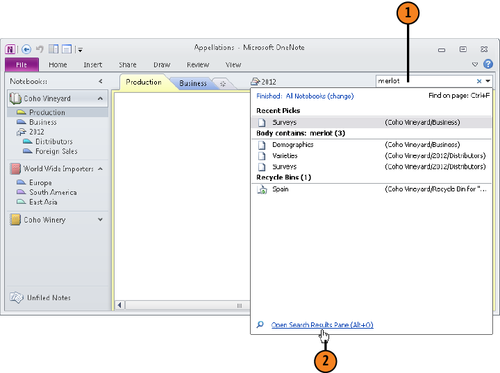4. Refining Searches with the Search Results Pane
Sometimes while conducting a search, you need to change the scope. You have to expand or narrow the search to find a note you are looking for.
To refine searches, OneNote
offers the Search Results pane. After you initially conduct a search,
press Alt+O to open the Search Results pane. It appears on the right
side of the screen.
The Search Results pane presents these methods of refining a search:
On the Change Search Scope menu, choose an option to expand or narrow your search.
On the Sort by menu, choose an option to sort the search results by section name, page title, or date modified.
Click a page name in the
Search Results pane to visit a page. The Search Results pane not only
lists the names of pages; it also shows note contents. You can read
notes without having to go to a preview page.
4.1. Refine a Search with the Search Results Pane
Press Ctrl+E and enter a search term in the Search In box to conduct a search.
To open the Search Results pane, press Alt+O (or click the Open Search Results Pane link; it is located at the bottom of the search results list).

Open the Change Search Scope menu and choose This Notebook.
Open the Sort By menu and choose Sort by Date Modified.
Click a page name to preview the page.
Click the Close button (or press Esc) to close the Search Results pane.

5. Choosing the Default Search Scope
When you click in the Search In box (or press Ctrl+E) and enter a search term, OneNote initially searches using the default scope selection: This Section,
This Section Group, This Notebook, or All Notebooks. You can tell what
the default scope selection is by glancing at the Search box. If it
reads “Search All Notebooks (Ctrl+E),” for example, All Notebooks is the
default scope, and unless you choose a different search scope, searches
begin by finding notes in all open notebooks.
You can change the default
search scope so that initial searches find notes in an area of your
choice: This Section, This Section Group, This Notebook, or All
Notebooks.
To change the default
search scope, open the Change Search Scope menu and select the scope
option you prefer as the default: This Section, This Section Group, This
Notebook, or All Notebooks. Then open the Change Search Scope menu
again and choose Set This Scope As Default.
5.1. Choose a Default Search Scope
Open the Change Search Scope menu and choose This Notebook.
Open the Change Search Scope menu and choose Set This Scope as Default.

Tip:
You can always change the search scope in the middle of a search by opening the Change Search Scope menu and making a selection.